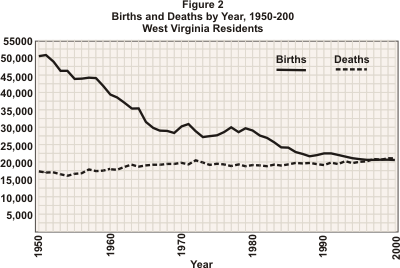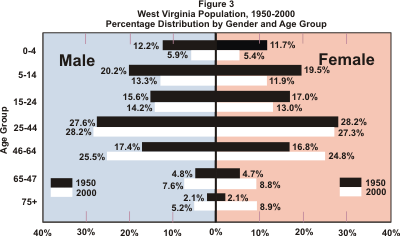 |
HSCStatistical BriefNumber 10October 2003 |
 |
A Look at West Virginia's Aging Population, 1950-2000
Brief No. 10
West Virginia’s population has decreased by approximately 200,000 since 1950. A county-by-county examination of this change can be found in the Health Statistics Center’s Statistical Brief No. 8: “A Look at West Virginia’s Population by Decade, 1950-2000.” The good news is that the decline in the state’s population that began in the 1950s was reversed in the 1990s, when nearly 15,000 people were added to the population.
The current brief analyzes the population changes that occurred by age during the past 50 years. As we will see, the number of younger West Virginians has declined significantly, while the number of older residents has increased. Figure 1 illustrates these changes. The largest decline has occurred among our youngest residents; the number of children aged four and under has decreased by approximately 57%. Conversely, the population of West Virginians aged 75 and older has ballooned, with the number of men increasing by 115% and the number of women by 284%.

Declining Populations. In 1950, there were 239,312 children between the ages of 0-4; according to the 2000 census, this number has decreased to 101,805. The number of children aged 5-14 declined from 398,241 in 1950 to 227,332 in 2000. West Virginia had 327,192 youths (15-24) in 1950 compared to 245,687 in 2000. There were 559,423 young adults (25-44) in the Mountain State in 1950, compared with 501,343 in 2000.
Increasing Populations. The “Graying of America” has begun in West Virginia. Compared to 343,156 people aged 45-64 in 1950, there were 455,282 in 2000. The population of residents aged 65-74 increased from 94,833 to 148,463. However, the number of people aged 75 and older has nearly tripled, from 42,896 to 128,432.
The ratio of births to deaths over the five decades provides a partial explanation for the aging of West Virginia. State births averaged over 46,000 per year in the 1950s, decreasing to about 33,600 in the 1960s, 29,000 in the 1970s, under 25,000 in the 1980s, and just 21,400 in the 1990s. In 2000, West Virginia had the lowest birth rate in the nation, 11.6 births per 1,000 population, compared to a U.S. rate of 14.7. Deaths, on the other hand, averaged approximately 17,000 in the 1950s and have increased slightly over time. Figure 2 shows the comparison of births and deaths in the state since 1950. Deaths actually began to exceed births beginning in 1997, resulting in a natural decrease in the population.

Population Distribution Decreases. Not only has the number of people changed in each age group, but the percentage each group represents in the total population has shifted as well. Young children (aged 0-4) accounted for 11.9% of the total population in 1950. In 2000 that proportion had shrunk to only 5.6%. One of every five residents (19.9%) in 1950 was a child between the ages of 5-14. Now it is approximately one of eight (12.6%). Young people aged 15-24 comprised 16.3% of the population in 1950, compared with 13.6% in 2000. Adults aged 25-44 represented the only constant proportion over the years, 27.9% in 1950 and 27.7% in 2000.
Population Distribution Increases. Older adults ages 45-64 have increased from slightly over one of every six (17.1%) residents in 1950 to just over one in four (25.2%) in 2000. The proportion of the population made up of citizens aged 65-74 has nearly doubled since 1950, from 4.7% to 8.2%. People aged 75 and older accounted for only 2.1% of the state’s population in 1950; by 2000 this had risen to 7.1%, from about one of every 50 residents in 1950 to one in 14 in the most recent census. Figure 3 illustrates the distribution of West Virginia’s population by age group and gender in 1950 and 2000.

Median Age. In 1950, West Virginia had a fairly young population nucleus, as did the rest of the nation. The state's median age at that time was 25.1 years. As in the rest of the country, the median age of West Virginians increased over the decades, to 28.5 years in 1960, 30.0 in 1970, and 30.4 in 1980. By 1990, the median age had risen drastically to 35.4 years, the second oldest population in the nation. The 2000 census placed West Virginia at the top with a median age of 38.9, replacing Florida, the leader since 1970.
Table 1 presents a comparison of the median ages in West Virginia and the United States since 1950 by gender.
| Table 1 Median Age by Gender, West Virginia and United States, 1950-2000 |
||||||
|---|---|---|---|---|---|---|
| Year | Total | Male | Female | |||
| WV | US | WV | US | WV | US | |
| 1950 | 25.1 | 25.2 | 25.2 | 24.9 | 25.0 | 25.5 |
| 1960 | 28.5 | 29.5 | 27.6 | 28.7 | 29.2 | 30.3 |
| 1970 | 30.0 | 28.1 | 28.4 | 27.5 | 31.5 | 28.8 |
| 1980 | 30.4 | 30.0 | 29.1 | 28.8 | 31.7 | 31.2 |
| 1990 | 35.4 | 32.9 | 34.0 | 31.7 | 36.7 | 34.1 |
| 2000 | 38.0 | 35.3 | 37.5 | 34.0 | 40.2 | 36.5 |
Average Age at Death. Another reason for the West Virginia's aging population is the fact that our residents are now living longer. Since 1950, the average life span of West Virginians has increased by 16 years; males now live an average of 13 years longer, while females live an average of 18 years longer. In 1970, 36 West Virginia residents died who were over the age of 100 years; in 2000, this number had risen to 144. Table 2 shows the average age at death among West Virginians by gender since 1950.
| Table 2 Average Age at Death by Gender, West Virginia Residents, 1950-2000 |
|||
|---|---|---|---|
| Year | Both Genders | Males | Females |
| 1950 | 57.1 | 56.2 | 58.5 |
| 1960 | 64.0 | 62.8 | 65.8 |
| 1970 | 65.3 | 63.6 | 67.6 |
| 1980 | 67.8 | 65.1 | 71.2 |
| 1990 | 71.3 | 68.3 | 74.7 |
In short, the "Graying of West Virginia" is the result of two primary factors. The decline in the number of births has resulted in a decrease in both the number and percentage of young people in our population. On the other end of the spectrum, the longer lives many West Virginians are enjoying have added to the number and proportion of older residents in our population. This is a nationwide phenomenon that happens to be occurring more quickly in West Virginia than in the rest of the country.
According to an article by the Associated Press on February 14, Centers for Disease Control believe that the number of Americans 65 or older is expected to increase from 35 million in 2000 to nearly 71 million by 2030. In addition, the percentage of elderly people is expected to rise from 12.4 percent to nearly 20 percent by then. In other words, the ratio of older people in this nation is now approximately one of every eight, by 2030 it could be one of every five.
For West Virginia, the projected elderly population ages 65 and older according to the U.S. Census Bureau is expected to be around 25 percent by the year 2025 (the latest the Census has forecasted). In 2000, that percentage was 15.3%. Approximately one of every six people in the Mountain state was older than 65 in 2000. By 2025, that could one of every four.